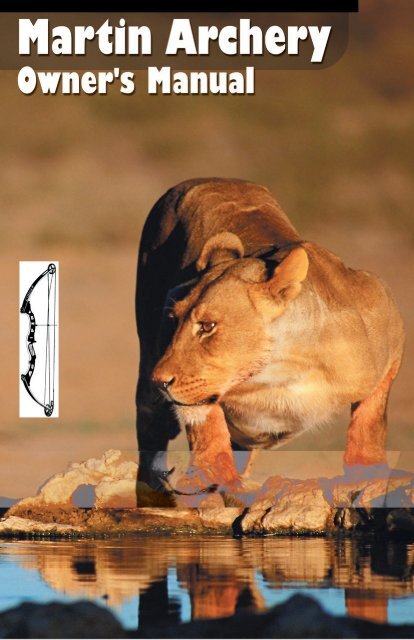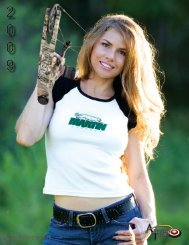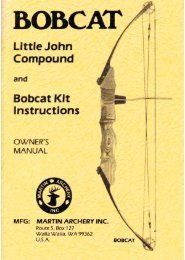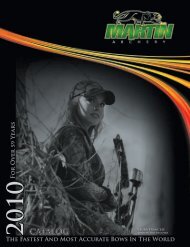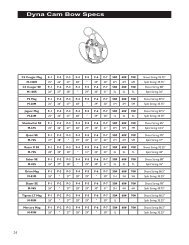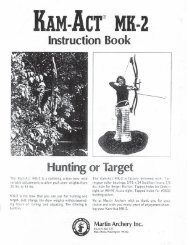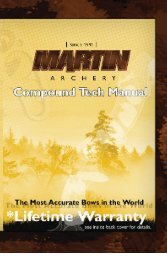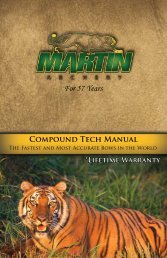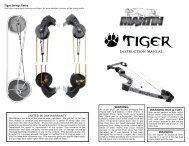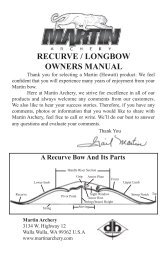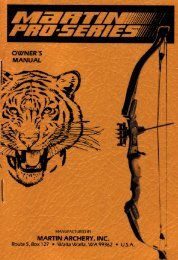Create successful ePaper yourself
Turn your PDF publications into a flip-book with our unique Google optimized e-Paper software.
Welcome to the <strong>Martin</strong> <strong>Archery</strong> Family. We are confident that you willexperience many years <strong>of</strong> enjoyment from your new <strong>Martin</strong> bow. Each bow thatleaves our door is handmade one at a time as they have been for fifty years. <strong>Martin</strong><strong>Archery</strong> remains a family owned and operated business. We take great pride inevery product we produce and we strive to <strong>of</strong>fer you the most complete line <strong>of</strong>pr<strong>of</strong>essional accessories available.We welcome any comments you may have about our products. We alsolike to hear stories <strong>of</strong> your successes while using our products. If you have anycomments, photos, or information you would like to share with us, please call orwrite. We will do our best to answer any questions you may have.To better serve you, we have the most complete archery manufacturersWeb page on the World Wide Web. Our home page includes a hot link directly toour E-Mail box so you can keep in touch with us.Our Web page is located at: www.martinarchery.comOur E-Mail address is: martin@bmi.netThank You,2Gail <strong>Martin</strong>Founder and President<strong>Martin</strong> <strong>Archery</strong> Inc.
TABLE OF CONTENTSOWNERS RECORD .........................................................................................4PARTS OF THE BOW ......................................................................................5BASIC SETUP• Cable Guard Installation............................................................................6• Setting Draw Length...................................................................................6• Changing draw weight................................................................................7• Setting Tiller.................................................................................................7• Wheel Timing (For Two Cam Systems)................................................... 8• Setting Arrow Rest Position......................................................................9• Setting Nock Point......................................................................................9• Replacing The Strings..................................................................................... 9• Care And Storage .......................................................................................9THE FUZION SINGLE CAM SYSTEM • Adjusting The Draw Length.....................................................................10• Setting The Tiller.........................................................................................10• Using The Adjustable Perimeter Weight................................................. 11• String Configuration...................................................................................11THE FURY CAM• Getting Peak Performance.........................................................................12• Cam Positioning..........................................................................................12THE Z CAM• Setting Draw Length...................................................................................6• Changing draw weight................................................................................7• Setting Tiller.................................................................................................7FINE TUNING YOUR COMPOUND BOW• Bare Shaft Planing Test..............................................................................13-14• Paper Tuning................................................................................................15-17SUPER FINE TUNING• Short Range Group Tuning.......................................................................18• Flight Tuning Broadheads.........................................................................19TEN COMMANDMENTS OF ARCHERY SAFETY ........................... 20FREQUENTLY ASKED QUESTIONS ...................................................... 21MARTIN WARRANTY .....................................................................................223
OWNER'S RECORDBOW MODEL:__________LIMB TYPE:_________________________________CAM:_________________________________DRAW WEIGHT:_________________________________DRAW LENGTH:_________________________________STRING LENGTH:_________________________________PURCHASED FROM:_________________________________DATE:_______________________________NOTICE:STAPLE YOUR SALES RECEIPT HERE.PROOF OF PURCHASE DATE ISNEEDED SHOULD YOU EVERREQUIRE WARRANTY WORK.4
PARTS OF THE BOWIdler WheelAxleSplit StringUpper LimbLimb BoltRiserSlide Slot RestMounting HoleGripShooting StringBarrel NutQuiver MountsUp-MountCable GuardLock MountRest MountingSystemStabilizer InsertLimb PocketLower LimbAdjustablePerimeter Weight(Optional)Fuzion Cam(Cougar 2000 with Fuzion Cam System)5
BASIC SETUPYour new <strong>Martin</strong> bow takes little setup to get started shooting. Please read andfamiliarize yourself with these starting procedures before shooting. Many <strong>of</strong> theseprocedures will have been completed by your authorized <strong>Martin</strong> dealer. Aftercompleting these simple steps, you will be more accurate and will have greater successfrom the start. A careful and thorough initial setup will make the tuning processmuch easier.CABLE GUARD INSTALLATIONThe Jaguar Fuzion and Jaguar Magnum models areequipped with an upper mounted cable guard that mountsto the risers 10-24 threaded mounting holes. Speciallydesigned for use with the short axle lengths and Fuzionsingle cams utilized by these models, this mountincorporates a dove-tail slide for mounting sights andquivers.All other <strong>Martin</strong> compound bow models*feature smooth bore holes in the riser that allow direct,bracket-free installation <strong>of</strong> the cable guard rod. There areset screws within the riser that will secure the rod.The cable guard rod should be rotated toward the gripto provide adequate fletching clearance. Caution shouldbe taken against over-rotating the rod as excessive clearancecan cause unnecessary pressures on the limb tips andaxle bushings. Only 9/16” <strong>of</strong>f-set is necessary to provideadequate fletching clearance.SETTING DRAW LENGTHZ Cams and Mini Z CamsThe Z Cam uses draw length modules to adjust thedraw length. The size <strong>of</strong> each module is designated by anumber followed by an 'X'. These modules are sized from2X to 9X. The 9X makes the longest draw and the lengthdecreases one inch for each number. To change the drawlength on these cams, simply remove the two screwsholding the module to the cam. Take a look at the modulenumber and select a new module that will give you the correctdraw length. Install the new modules, making sure thatthe numbers on each module match.CableGuardThough most bow models allow either an upper (above the arrow rest) or lower(below the grip) mounting, <strong>Martin</strong> <strong>Archery</strong> recommends the upper mountingposition on all Fuzion single cam models.*As <strong>of</strong> this writing, the Scepter II and Bobcat models did not allow the direct installation<strong>of</strong> a cable guard rod. A mounting bracket is supplied with these models thatthreads into the threaded holes provided in the back <strong>of</strong> the riser.6
Fury CamsThe Fury Cam is a draw length specific cam. Each cam was designed to give peakperformance and speed at each specific draw length. Therefore, changing the drawlength requires changing to a different size cam.NOTE: Do not draw your bow without the modules installed. It will causedamage to your harness system.Fuzion Single Cam SystemA full explanation on the Fuzion Cam System, including changing the draw length,can be found on page 10 and 11.CHANGING DRAW WEIGHT<strong>Martin</strong> bows have a fifteen pound draw weight range. Using the 3/16” Allen wrenchsupplied with each bow, you will turn the limb bolts clockwise to add weight and turncounter clockwise to reduce weight. One complete turn on each limb bolt providesabout 4 pounds <strong>of</strong> adjustment.TIP: Mark a line on each limb bolt in white-out or white paint marker to make iteasier to keep track <strong>of</strong> how far you are turning each bolt.NOTE: Do not shoot your bow with the limb bolts more than 5 turns out from theriser.SETTING TILLERAfter setting the draw weight on your bow, you willneed to set the tiller measurement to make sure thatyou have adjusted your limbs properly. On all <strong>Martin</strong>compound bows, “0” tiller will shoot perfectly.However, the tiller measurement can vary up to 1/4” closerat the bottom. There is no set measurement that providespeak performance for every shooter. To measure your tiller,simply measure from the limb pockets to the string onboth ends <strong>of</strong> the bow (see Fig.1). You can custom fit thefeel <strong>of</strong> your bow by experimenting with the tiller setting.Start with even tiller, when both top and bottom limbsare adjusted the same. (Before adjusting your limb bolts,mark a white line from the center <strong>of</strong> the limb bolt to theoutside. This will help you keep track <strong>of</strong> your settings.) Bytightening one bolt a quarter turn at a time you will beginto affect the steadiness <strong>of</strong> your setup. If the bow begins tobecome unsteady, move the tiller back to even and tightenthe opposite limb bolt. After finding the best spot, make anote so if you ever change the draw weight you can reset thetune where you had it shooting best (i.e., 3/4 bottom wouldmean three quarters <strong>of</strong> a turn on the bottom limb bolt).NOTE: Your peep sight position and your nock pointwill change as you turn one limb bolt. Take measurementsand correct your nock and peep each time youturn your bolts.7Fig.1
WHEEL TIMING (FOR TWO CAM SYSTEMS)It is important for consistency and accuracy that your bow’s cams “roll over” atthe same instant and are in the same position when you are at full draw. Your camsshould be synchronized or “timed” to your particular style <strong>of</strong> shooting. To check thetiming, draw your bow with your fingers or release just as you would while shooting.Different drawing methods will affect the roll over <strong>of</strong> your cams. Draw the bow usingyour exact shooting method.Cams are in perfecttime.Upper Cam isover-rotated andout <strong>of</strong> sync withthe bottom camAdjust this yokeby twisting upthe bottom SplitString cable.Adjusting timing using the Split String System (synthetic cables)This procedure can be expertly performed by yourString Anchorlocal archery pr<strong>of</strong>essional. You will need a bow pressor a bow stringer to adjust your timing using the SplitString System. First, determine which cam is ahead, orout <strong>of</strong> sync. The Split Strings, or buss cables, shouldSplitreach the end <strong>of</strong> the cable grooves on the PowerStringSide (back side) <strong>of</strong> each cam at the same time. Then,while the bow is relaxed, remove the appropriate SplitString <strong>of</strong>f its outside posts and twist in a directionthat shortens or tightens the cable. A few turns willgo a long way so proceed sparingly. If your top cam isahead, or rotates further than your bottom cam, twistthe bottom Split String, do the opposite if the bottomwheel is ahead. After these steps are completed makesure that all <strong>of</strong> your string loops are firmly secured ontheir appropriate pegs before the pressure is reappliedto the bow.NOTE: Back your bow limbs out five turns from the riser before using a bow stringeror a bow press. Only let a qualified pr<strong>of</strong>essional put your bow in a bow press.8
SETTING ARROW REST POSITIONAfter your arrow rest is installed on your bow, you will needto set the rest to the best centered location to begin tuning. Theeasiest way to do this is to visually align the bowstring in thecenter <strong>of</strong> the grip section. If you are shooting your bow witha release aid, the prongs or blade <strong>of</strong> your shoot-through restwill need to be centered with the bow string. During tuning,your arrow rest may need to be moved in or out from it’s centeredlocation. This is normal because different shooters applydifferent pressures to the bow. Finger shooters will need to positionthe rest so that the point is about 1/8” outside the string.This is to compensate for the horizontal bending <strong>of</strong> the arrowupon release. An arrow rest that provides some side support,such as a cushion button, for the arrow is best for finger shooters.BowstringSETTING NOCK POINTPlace a bow square on the string and slide the square downuntil it rests on your arrow rest. Then place a moveable nockset on the string. Using the measuring scale on the bow square,set the nock set at the proper location on the string. A goodstarting point for finger shooting is 1/4” high, measuring fromthe bottom <strong>of</strong> the nock set to 90° on the bow string. Start at¼” high if you are using a release aid. If you do not have a bowsquare, you can snap an arrow on the string and visually levelthe arrow. Then crimp your nock set. In a pinch, this will getyou to a good starting location.1/21/490 0REPLACING THE STRINGSShould your string need replacing, it is best to go to your <strong>Martin</strong> dealer and have itexpertly done. It is recommended that you replace your string once a year or anytimeit shows wear. Always be sure that the string you replace it with is the correct lengthand material for your bow.CARE AND STORAGEWhen properly cared for, your new <strong>Martin</strong> bow will give you years <strong>of</strong>trouble-free service. When your bow is new it will require no lubrication. Over timeyou may need to lubricate your cams to guard against friction and noise. Use a drylubrication such as Teflon spray powder or graphite powder. Do not use wet or oilylubrication. Using a wet type lubrication will attract grit and dust that may causepremature wear in wheel bushings.A good rule <strong>of</strong> thumb when caring for your bow is to keep it as comfortable asyou are. If it is too hot for you, it is too hot for your bow. If it gets wet, dry it <strong>of</strong>fcompletely. Periodically clean your bow with a wet rag and mild soap to removemud or dust (caution: do not store until completely dry). Prolonged exposure toextreme heat may cause failure in your bow limbs and excessive stretch in your harnesssystem. It will not hurt your bow if it is rained on while shooting, but make sure it iscompletely dry before storing in a bow case to guard against rust or corrosion.9
THE FUZION SINGLE CAM SYSTEMThe Fuzion system is unique among all other single cam systems. The Fuzionsystem has an Adjustable Perimeter Weight, modular draw length adjustment, and canbe adjusted in half inch adjustments within each draw length module.ADJUSTING THE DRAW LENGTHThe Fuzion Single Cam System boasts arevolutionary design and is engineered to give youpeak performance and speed. Using draw lengthmodules, the draw length can be adjusted in 1"increments (see fig. 1) The modules can also beused to adjust the let-<strong>of</strong>f. A high let-<strong>of</strong>f module ismarked as F-#. A 65% let <strong>of</strong>f module is markedwith a F-#\. The slash on the end <strong>of</strong> the sizenumber indicates 65% let-<strong>of</strong>f. To change the drawlength replace the module on the cam by removingthe screws that hold it to the cam (see Fig.3).NOTE: do not draw your bow without the moduleinstalled. It will damage your harness. TheFuzion module sizes range from F-2 to F-7. Ifyou would like to increase the draw length select ahigher number. If you would like to decrease theFig.1draw length select a lower number. The draw lengthcan also be adjusted up or down ½" using the pegs on the back <strong>of</strong> the cam (see fig.1).The #2 peg is the prescribed draw length for each module. The #1 peg is ½" longerand the #3 peg is ½" shorter. The draw weight will change one pound, accordingly,when using the peg adjustment.SETTING THE TILLERYour Fuzion bow should start out with an even tiller setting. Even tiller, or "0"tiller, makes sure both limb bolts are adjusted evenly. Single cam systems do not allowthe string to be parallel with the riser. The tiller cannot be measured in a standardmanner. To check the tiller on the Fuzion System, stretch a thin string or dental flossfrom axle-to-axle and measure from each limb cup to the dental floss. (see Fig.2)Fig.210
USING THE ADJUSTABLE PERIMETER WEIGHT (OPTIONAL)The Adjustable Perimeter Weight in the Fuzion system is used to enhancesmoothness and speed. Different models, bow weights, draw lengths, and arrowweights will cause the Perimeter Weight to affect performance differently. Bychanging the position <strong>of</strong> the Perimeter Weight, adding a second weight, or leavingthe weight out altogether, you can custom tune your Fuzion bow to your ownpersonal preferences.Fuzion Module#3054 F2 - F7Fuzion Cam#3050PerimeterWeight #3053Slot forweightsBP-6 modulescrewsFig.3STRING CONFIGURATIONThe string harness on the new Fuzion are installed according to the diagram below(see Fig.4). Your string harness should be installed by your qualified <strong>Martin</strong> dealer.ShootingStringSplitStringFig.411
THE FURY CAMGETTING PEAK PERFORMANCEThe Fury Cam is designed to provide optimum performance when thedraw weight is at its maximum setting. In order to attain the top performanceexpected from this Cam system, it is strongly recommended that the draw weightbe set at its maximum. This setting will also keep noise to a minimum and benefitaccuracy.CAM POSITIONINGIn order to achieve the ideal draw force curve and resulting maximumefficiency, the Fury Cams need to be positioned properly. Though the exact camposition is not critical, the straight section <strong>of</strong> the cam should be aligned vertically andparallel with the bowstring (see diagram). No exact measurement is required, just avisual check will be sufficient. Should the bow string stretch abnormally, the straightsection <strong>of</strong> the cam can rotate closer to the bowstring, increasing draw length and drawweight while adversely affecting performance. Add twists to the bowstring to reduceits length and return the cam back to its proper alignment.Properorientation<strong>of</strong> string andCam point.Proper campositioning asseen on thebow. Thispositioningapplies to anybow using theFury Cam.12
FINE TUNING YOUR COMPOUND BOWAfter completing the basic setup procedures, you are now ready to fine tune yoursetup for the best accuracy possible. There are four tuning methods described in thissection. Some <strong>of</strong> these methods may not apply to certain styles <strong>of</strong> shooting. Read theintroduction to each method carefully to make sure it applies to your shooting style.BARE SHAFT PLANING TESTThe Bare Shaft Planing method <strong>of</strong> tuning works best when using a finger release. Tobegin the Bare Shaft Planing test you will need three fletched arrows and one or twobare shafts. You will also need a target that will catch the arrows without allowing thearrow to kick as it stops in the target. This test will help you establish the correct nockand rest position, and it will tell you if your arrow is the correct spine. Porpoising andFish Tailing describe the different flight disturbances you will encounter while tuning.PorpoisingPorpoising is identified by an up and down kick during arrow flight and relates tothe nock point adjustment. It is important to correct porpoising first because smallleft and right disturbances could be nock point related. Start at about ten to fifteenyards and shoot three fletched arrows into your target. Using the same aiming point,follow them up with a bare shaft. After you get the shafts to impact with the fletchedshafts, you may want to try shooting them at a longer distance for a finer indication<strong>of</strong> arrow flight.A high nock set will cause porpoisingIf the bare shafts impact below the fletched arrows, your nock point is too high.Move your nocking point down in small increments until the bare shaft strikes withthe fletched shafts. If the bare shafts impact above your fletched arrows, your nockpoint is too low. Lower your nock point in small increments until your fletchedarrows and your bare shaft impact together.Repeat the above steps from a longer distance to make sure you have completelycorrected the nock point. Shooting from a longer distance will make minordisturbances more apparent.Low nocking point13High nocking point
FishtailingFishtailing relates to the arrow rest adjustment and the stiffness <strong>of</strong> yourarrow. Just as before, start at about ten to fifteen yards and shoot three fletched arrowsinto your target. Using the same aiming point, follow them up with a bare shaft. Afteryou get the shafts to impact with the fletched shafts, you may want to try shootingthem at a longer distance for a finer indication <strong>of</strong> arrow flight.If your unfletched shafts impact to the left <strong>of</strong> your fletched shafts, your arrow is toostiff. There are several things that you can do to correct this problem; you can selecta weaker arrow, you can decrease the cushion plunger tension. Increasing the peakweight <strong>of</strong> your bow or increasing your point weight will also make your arrow act abit more limber. If your unfletched shafts impact to the right <strong>of</strong> your fletched shafts,your arrow is too limber. There are several methods you can try that will correct thisproblem; you can select a stiffer arrow, you can increase the cushion plunger tension.Decreasing the peak weight <strong>of</strong> your bow or decreasing your point weight will alsomake your arrow act a bit more stiff.To further fine tune your setup, step back to twenty or thirty yards and repeat theabove procedures. Small flight disturbances will show up better as you get fartherfrom the target. Your <strong>Martin</strong> bow is essentially tuned when your bare shafts hittogether with your fletched shafts. Keep in mind that if you continue and completethe super fine tuning methods in this manual, it is not uncommon for your bare shaftimpact to change. Your bow will be shooting its best and it is common for a perfectlytuned bow to shoot a bare shaft a bit low and right or low and left. Perfect arrowgroups are the goal when completing these exercises.Stiff Arrow- bareshafts fly to left.Limber Arrow-bareshafts fly to right.14
PAPER TUNINGPaper tuning will work for all styles <strong>of</strong> shooting. As you are going through thesesteps keep in mind that paper tuning is not chiseled in stone as the law <strong>of</strong> archery. Itis a guideline for clean arrow flight. Many shooters find that their setup groups bestwhen achieving less than perfect tuning results. For example, some target shooters settheir bows to tear slightly high through the paper. They feel this makes their arrowflight less likely to be influenced by outside variables like wind or rain and helps arrowclearance when using a shoot-around type rest such as a blade or pan type launcher.To begin paper tuning, set up a frame or rack with paper suspended from theframe. Position the frame far enough away from your backstop so the arrow cancompletely clear the paper. Stand about ten feet from the paper and make sureyour arrow is level as it flies through the paper. Fire a test shot and read the results.Compare the holes you have made in the paper to the diagrams below. Proceduresfor correcting the tear are listed next to each diagram. Please note that tuningprocedures recommended for finger shooting <strong>of</strong>ten differ from those used forrelease shooting. You will find that the arrow spine reaction is different for fingersand release, therefore, the procedures for correcting the different disturbances vary.Follow the instructions carefully for your particular shooting style.HIGH TEAR (fletching tears above point)This tear may signal:•Nocking point too high.Lower the nocking point.•Improper vane clearance.See if arrow fletching is hitting the rest.•Launcher is too stiff (release shooters).Weaken spring tension or use a more limber launcher.•Wheels may be out <strong>of</strong> time.Check wheel timing.•Arrow may be too limberSelect a stiffer arrow shaft.•Tiller adjustment may be incorrect.See basic setup section page 7.•Irregular or inconsistent shooting form.See a qualified archery coach or pr<strong>of</strong>essional and have them check your technique.LOW TEAR (fletching tears below point)This tear may signal:•Nocking point too low.Raise the nocking point.•Wheels may be out <strong>of</strong> time.Check wheel timing.•Tiller adjustment may be incorrect.See basic setup section on page 7.•Irregular or inconsistent shooting form.See a qualified archery coach or pr<strong>of</strong>essional and have them check your technique.15
RIGHT TEAR (fletching tears to theright <strong>of</strong> point)This tear may signal:Note: If you are left handed follow these instructions in reverse.FINGERS:•Stiff arrow.This problem is cured using the following methods:a. Increase peak weight.b. Use a heavier point.c. Select a more limber arrow.d. Lighten cushion plunger tension, or use a weaker spring on shoot around rests.e. Make small incremental rest adjustments towards the bow.RELEASE:•Arrow rest is too far to the right.Move arrow rest to the left.EITHER STYLE:•Too much pressure on the cable guard.Rotate cable guard for minimum fletching clearance.•Irregular or inconsistent shooting form.See a qualified archery coach or pr<strong>of</strong>essional and have them check your technique.•Clearance problem.See that arrow has adequate fletching clearance.LEFT TEAR (fletching tears left <strong>of</strong> point)This tear may signal:Note: If you are left handed follow these instructions in reverse.FINGERS:•Weak arrow or a clearance problem.This problem is cured using these methods:a. Reduce bow weight.b. Use a lighter point.c. Select a stiffer arrow.d. Increase cushion plunger tension or use a stiffer spring on shoot around rests.e. Make small incremental rest adjustments away from the bow .RELEASE:•Arrow rest is too far to the left.Move the arrow rest to the right.•Arrow is too stiff.Decrease bow weight or select a weaker arrow.EITHER STYLE:•Arrow is not properly clearing cables.Rotate cable guard for minimum fletching clearance.•Irregular or inconsistent shooting form.See a qualified archery coach or pr<strong>of</strong>essional and have them check your technique.•Clearance Problem.See that arrow has adequate fletching clearance.16
MULTIDIRECTIONAL TEARThis tear may signal:•More than one problem with accessory adjustment.Move nock adjustment first until the tear is horizontal and followinstructions for horizontal tear.•Clearance Problem.See that the arrow has adequate fletching clearance.•Wheels may be out <strong>of</strong> time.Check wheel timing.•Irregular or inconsistent shooting form.See a qualified archery coach or pr<strong>of</strong>essional and have them check your technique.PERFECT HOLEThis pattern shows clean arrow flight. The point and fletchingimpacted the same location. Your bow is now ready to shoot or youmay want to continue and try some <strong>of</strong> the super fine tuning methods.AFTER ADJUSTINGAfter you have completed these steps and have achieved good paper testresults, it is best to try it at fifteen and twenty feet just to make sure you did not get afalse reading. A good rule to go by when paper tuning is to move your nock point orarrow rest opposite the tear when using a release. In some rare cases if this does not clearup your tear you may need to move your accessories in the same direction as the tear.17
SUPERFINE TUNINGSHORT RANGE GROUP TUNINGShort range group tuning will work with any style <strong>of</strong> shooting. Best results areachieved when this method is used after completing the Bare Shaft Planing or PaperTuning tests. This is a good ultra fine tuning method when space will not permit longrange shooting. After completing the following steps you will have very clean arrowflight and a well tuned, accurate setup.To begin the short range tuning method, you will need a piece <strong>of</strong> cardboard, or atarget face will do nicely. Make a broad line through the center <strong>of</strong> the paper on theblank side, making sure the line is thick enough to see from twenty yards. Start at about10 to 15 yards from the target. Use your tuning target and position the line verticallywhen you are tuning the arrow rest and position the line horizontally when you aretuning the nock point.This patternshows averticaldisturbance.Vertical ImpactPosition your line horizontally and shoot six arrows at the line. Concentrate on keepingyour pin on the line. Don’t worry about left and right hits, just try to keep yourshots on the line. Shoot two good groups, discarding any rough or bad shots, and notethe vertical impact <strong>of</strong> the arrows and their relationship to the line. All adjustments aremade with the nock point during these steps.If your arrows are not consistently grouping on the line, make small 1/32"adjustments up or down with the nock point and shoot two more groups. Continuemaking nock adjustments in small increments. If all <strong>of</strong> your arrows begin to hit onthe line you are correcting the nock position. In the event that your groups widen,move your nock back to its original location and make small adjustments in the oppositedirection.This patternshows ahorizontaldisturbance.This patternshows a cleanhorizontalpattern.This patternshows a cleanverticalpattern.Horizontal ImpactAfter achieving a nice, straight, horizontal pattern, rotate your target so your line willappear vertical. Just as before, shoot two good groups, discarding any rough or badshots, and note the horizontal impact <strong>of</strong> the arrows and their relationship to the line.All adjustments are made with the arrow rest during these steps.If your arrows are not consistently grouping on the line, make small 1/32"adjustments left or right with the arrow rest and shoot two more groups. Continuemaking rest adjustments in small increments. If all <strong>of</strong> your arrows begin to hit on theline you are correcting the rest position. In the event that your groups widen move yourrest back to its original location and make small adjustments in the opposite direction.18
FLIGHT TUNING BROADHEADSBroadhead tuning will work for all styles <strong>of</strong> shooting. After you havecompleted one or more <strong>of</strong> the tuning procedures described in this manual, you canproceed with this final test to get your new bow ready to hunt. You will need threefletched arrows with field tips and three with broadheads that weigh the same as yourfield tips.Before you begin shooting, you will need to check your broadhead equippedarrows. After installing your broadheads, make sure they are perfectly straight on theshaft. This can be done by spinning the arrow on a flat counter while checking forany broadhead wobble. You can also use a commercially made spin check tool that isavailable from your dealer. After all <strong>of</strong> your broad heads are spin-checked and straightyou are ready to begin.Set up a broadhead target at twenty or thirty yards and shoot three arrows withfield tips. Make sure you are properly warmed up and you are shooting to thebest <strong>of</strong> your ability. Next, shoot three identically aimed arrows with broadheads.WARNING: NEVER SHOOT BARE SHAFTS WITH BROADHEADS AT-TACHED. THE FLIGHT WILL BE EXTREMELY UNPREDICTABLE ANDDANGEROUS. Once you have shot the best group you can shoot, compare theposition <strong>of</strong> the broadhead group to the field tip group. Compare the groups to thediagram below and make very small incremental adjustments as described next tothe broadhead group that corresponds to your arrow pattern. Note: make very small1/32" adjustments. A small adjustment will greatly change your broadhead flight.Multidirectional FlightCorrect the nock point first.Once the arrow is straight left,follow instructions for leftflight.Left FlightRelease:Move arrow rest tothe right in smallincrements.High FlightRaise nock pointField Point GroupBroadhead GroupRight FlightRelease:Move arrow restto the left insmall incrementsFingers:•Slightly increasedraw weight.•Use a heavierbroadhead.•Decrease cushionplunger tension.•Move plunger toward thebow in small increments.Reverse steps for left hand shooter.Fingers:•Sightly decreasedraw weight.•Use a lighterbroadhead.•Increase cushionplunger tension.•Move plunger awayfrom the bow in small increments.Reverse steps for left hand shooter.Low FlightLower nock point19
TEN COMMANDMENTS OF ARCHERY SAFTYNever - “Dry fire your bow” or shoot it without an arrow. This will result indamage to your bow.Never - Let anyone draw or shoot your bow if their draw length is longer thanyours. Over drawing <strong>of</strong> the bow can cause cable damage.Never - Draw, aim, or shoot your bow unless you are sure that the line <strong>of</strong> fire isclear. Remember, once an arrow is fired it cannot be recalled.Never - Shoot an arrow that is less than five grains per pound. For example, an80# bow requires a minimum <strong>of</strong> 400 grains <strong>of</strong> arrow weight. Less thanfive grains per pound <strong>of</strong> arrow weight simulates a dry fire effect and maydamage your bow.Never - Expose your bow to extreme heat. Excessive heat, such as your car on ahot day, could lead to limb failure and premature wearing <strong>of</strong> the stringharness.Always - Check all <strong>of</strong> your arrow shafts and nocks upon removal from the target.Do not shoot any arrows that show defects or broken nocks.Always - Carefully inspect your bow after each use. Be sure all screws aresnug and accessories are tight. Inspect your string and cables for wearor damage.Always - Draw your bow while pointing it at the target. A premature release <strong>of</strong> thearrow can be very dangerous. If you cannot draw your bow whilepointing it at the target without excessive movement, lower the peakweight <strong>of</strong> your bow until you can draw smoothly and correctly. Over timeyouwill build up strength, and will be able to return to the higher weight.Always - Draw your bow with an arrow on the string while keeping it pointed in asafe direction. Never draw your bow with a release aid without an arrow.A release aid failure could result in the dry fire <strong>of</strong> your bow.Always - Back your limb bolts <strong>of</strong>f five full turns from the riser before putting it ina bow press. Only let a qualified pr<strong>of</strong>essional or a <strong>Martin</strong> authorized dealerput your bow in a bow press. Inexperienced use <strong>of</strong> a bow press or aT-stringer can result in damage to your bow. This type <strong>of</strong> damage causedby a press is not covered under the <strong>Martin</strong> <strong>Archery</strong> bow warranty.20
FREQUNTLY ASKED QUESTIONSIt is our goal at <strong>Martin</strong> <strong>Archery</strong> for you to realize your full potential as a new memberin the <strong>Martin</strong> family. We have some <strong>of</strong> the greatest shooters in the world shootingwith us and we are certain you can become one <strong>of</strong> them. Below are some <strong>of</strong> the mostcommonly asked questions about <strong>Martin</strong> archery equipment. We hope that thesequestions are useful to you.What arrows should I use with my <strong>Martin</strong> bow? It is very important for accurateshooting that your arrows are the correct spine, or stiffness, for your bow. Arrowsthat are too limber or too stiff will cause tuning and accuracy problems. Your localdealer has an arrow chart and can properly fit your bow with the correct shaft.Regardless <strong>of</strong> the material or manufacturer <strong>of</strong> the arrow, all arrows have to be thecorrect spine or stiffness for your bow.How is the draw length on my <strong>Martin</strong> bow measured? <strong>Martin</strong> <strong>Archery</strong> currentlymeasures draw length according to the recommended AMO standard. This standarddictates that the draw length be measured 1 ¾” forward <strong>of</strong> the pivot point, or mostinward point, <strong>of</strong> the grip.How can I make my <strong>Martin</strong> bow as quiet as possible? Though your bowis engineered to produce very little noise, it is important to remember that highperformance models, that store high levels <strong>of</strong> energy, are not generally as quiet asmoderate performance bows. A few ways to eliminate noise and vibration are:a. Install string silencers.b. Make sure all screws on your setup are snug (a small amount <strong>of</strong> Lock-Tite willhelp keep them tight).c. Set your draw weight closer to its maximum, lower settings can increase vibrationsand noise.d. Use a heavier arrow in order to absorb more <strong>of</strong> the bow's stored energy.e. Install mole skin between any attached accessory and the bows riser.At what weight setting will my bow perform best? Your <strong>Martin</strong> bow can be shotanywhere within its fifteen pound weight range. You will achieve the highest level <strong>of</strong>performance from any compound bow when it is set at its maximum draw weight. Themaximum draw weight setting maintains the engineered level <strong>of</strong> limb, cable, andbowstring tension for peak efficiency, while keeping noise and vibration to aminimum.I want to get the most arrow speed possible. How light can I make my arrowswithout causing damage to my bow? The durability <strong>of</strong> <strong>Martin</strong> bows isunsurpassed in the archery industry. All components <strong>of</strong> your new bow can withstandhigh levels <strong>of</strong> stress. Its unprecedented durability allows your <strong>Martin</strong> bow to easilyuse an arrow that weighs as little as 5 grains per pound <strong>of</strong> draw weight. Note: The<strong>Martin</strong> <strong>Archery</strong> warranty does not allow the use <strong>of</strong> an arrow weighing less thanfive grains per pound.What kind <strong>of</strong> string material can I use on my <strong>Martin</strong> bow? The strength <strong>of</strong> all<strong>Martin</strong> bows, regardless <strong>of</strong> what cable system you are using, allows the use <strong>of</strong> all<strong>of</strong> the low stretch materials in use today. S-4, Spectra FastFlight, and 450 Premiumamong others are all good materials, and they can be used on all martin bows without voiding your warranty.21
WARRANTYWhether your new bow is for hunting, 3-D, or for target shooting, you have made theright decision in choosing a <strong>Martin</strong>! Over forty years <strong>of</strong> archery experience are built intoevery <strong>Martin</strong> bow. You can be confident that your new bow is designed to provide years <strong>of</strong>faithful service, and <strong>Martin</strong> will always be around to back it with our rock solid warranty.LIMITED 5-YEAR WARRANTYYour <strong>Martin</strong> compound bow is guaranteed by <strong>Martin</strong> <strong>Archery</strong>, Inc. to be free fromdefects in materials and workmanship for a period <strong>of</strong> two (2) years from the date <strong>of</strong>purchase. Exceptions to this warranty include the bow string and synthetic cables, for whichthere is no warranty. During the remainder <strong>of</strong> this Limited Five Year Warranty, <strong>Martin</strong><strong>Archery</strong>, Inc. will <strong>of</strong>fer repairs or replacements at a cost <strong>of</strong> 50% the current suggested listprice.The warranty is conditioned upon pro<strong>of</strong> <strong>of</strong> date <strong>of</strong> purchase and other conditions listedbelow. IT IS IMPORTANT THAT YOUR SALES RECEIPT BE FILED IN A SAFEPLACE FOR FUTURE REFERENCE, AS REPAIRS WILL NOT BE PERFORMEDUNDER WARRANTY WITHOUT A COPY OF THE DATED SALES RECEIPT. <strong>Martin</strong><strong>Archery</strong>, Inc. warrants that your <strong>Martin</strong> compound bow will perform its intended functionif used in accordance with the instructions provided. This Limited Warranty covers onlythe replacement parts, labor, and return ground transportation costs performed by <strong>Martin</strong><strong>Archery</strong> Inc. to the customer. Transportation for the return <strong>of</strong> the bow to <strong>Martin</strong> <strong>Archery</strong>,Inc. are not covered. No C.O.D. shipments will be accepted by <strong>Martin</strong> <strong>Archery</strong>, Inc. Warrantyrepairs can be performed by an Authorized <strong>Martin</strong> Dealer, for which <strong>Martin</strong> <strong>Archery</strong>,Inc. will cover replacement parts and ground transportation costs to the Authorized Dealer.Labor costs for warranty repairs performed by Authorized Dealers are not covered by<strong>Martin</strong> <strong>Archery</strong>, Inc. <strong>Martin</strong> <strong>Archery</strong> makes no other warranty either expressed or implied,whether <strong>of</strong> fitness or <strong>of</strong> marketability, except as stated above. Any such additional warrantyis expressly disclaimed.Warranty limitations are as follows:1. If bow shows signs <strong>of</strong> misuse, alteration, or mishandling this warranty will be void. Use<strong>of</strong>arrows weighing less than five (5) grains per pound <strong>of</strong> draw weight isconsidered misuseand will void this warranty.2. Claimant must be the original purchaser. This warranty is not transferable.3. All returns to <strong>Martin</strong> <strong>Archery</strong> Inc. must be pre authorized. Owner must contact <strong>Martin</strong><strong>Archery</strong>, Inc. at (509) 529-2554 prior to shipping in order to obtain a ReturnAuthorization number.4. All accessory items must be removed from the bow prior to shipping. <strong>Martin</strong> <strong>Archery</strong>,Inc.will not be responsible for damage or loss <strong>of</strong> any accessory item left onthe bow.5. Warranty is not effective unless a copy <strong>of</strong> the dated sales receipt accompanies the bow.6. This warranty gives you specific legal rights. You may also have other rights whichvaryfrom state to state.* After acquiring a Return Authorization number, send bow to:<strong>Martin</strong> <strong>Archery</strong>, Inc.Rt. 5, Box 127Walla Walla, WA 9936222
NOTES
CoverPhotoShopCover.psd


